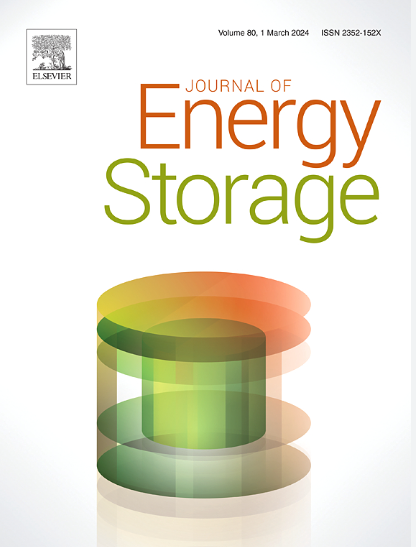Morphology engineering of NiCo2S4 for supercapacitor applications: A study on spherical and cubic structures
IF 8.9
2区 工程技术
Q1 ENERGY & FUELS
引用次数: 0
Abstract
This study investigates the effect of solvent composition on the morphology and electrochemical performance of NiCo2S4 (NCS) grown on nickel foam via a hydrothermal method. Different morphologies were prepared to explore how shape and structure affect electrochemical properties such as surface area and ion transport. By tailoring the morphology, it is possible to enhance the material's charge storage capacity for supercapacitor applications. By varying the water-to-ethylene glycol (EG) ratio, two distinct morphologies were obtained. A higher ratio (2:1) formed aggregated spherical particles (S-NCS), while a lower ratio (1:2) produced plate-like cubic shapes (C-NCS). A comprehensive XRD, FESEM, EDS, and elemental mapping techniques confirmed the successful synthesis of these morphologies. Structural analyses revealed that solvent ratio influenced crystallinity and particle size, with C-NCS exhibiting smaller crystallites and lower microstrain. Electrochemical tests revealed that S-NCS outperformed C-NCS, delivering a higher specific capacity (1112C/g vs. 898C/g at 1 A/g) and better cycling stability (86.4 % vs. 81.2 % retention after 5000 cycles at 8 A/g). In comparison, the asymmetric supercapacitor device of S-NCS//AC exhibited enhanced performance, achieving a maximum energy density of 68.8 Wh/kg at a power density of 400 W/kg, and maintaining a notable energy density of 22.2 Wh/kg even at a high-power density of 16 kW/kg. It also retained 83.1 % of its initial capacity after 5000 cycles at a current rate of 8 A/g. These results demonstrate that controlling NCS morphology through solvent ratio tuning significantly enhances supercapacitor performance.
用于超级电容器的NiCo2S4的形貌工程:球面和立方结构的研究
采用水热法研究了溶剂组成对NiCo2S4 (NCS)在泡沫镍表面生长的形貌和电化学性能的影响。制备了不同的形貌,以探索形状和结构如何影响电化学性能,如表面积和离子输运。通过调整形态,可以增强材料的电荷存储能力,用于超级电容器的应用。通过改变水与乙二醇(EG)的比例,得到了两种不同的形态。较高的比例(2:1)形成聚集的球形颗粒(S-NCS),而较低的比例(1:2)形成片状立方形状(C-NCS)。综合XRD, FESEM, EDS和元素映射技术证实了这些形貌的成功合成。结构分析表明,溶剂比影响了C-NCS的结晶度和粒径,C-NCS的晶体更小,微应变更低。电化学测试表明,S-NCS优于C-NCS,具有更高的比容量(1a /g时为1112C/g, 889c /g)和更好的循环稳定性(8a /g下循环5000次后的保留率为86.4%,81.2%)。相比之下,S-NCS//AC非对称超级电容器器件表现出更强的性能,在功率密度为400 W/kg时实现了68.8 Wh/kg的最大能量密度,即使在高功率密度为16 kW/kg时也保持了22.2 Wh/kg的能量密度。在目前8a /g的电流下,在5000次循环后,它还保留了83.1%的初始容量。这些结果表明,通过调节溶剂比来控制NCS的形态可以显著提高超级电容器的性能。
本文章由计算机程序翻译,如有差异,请以英文原文为准。
求助全文
约1分钟内获得全文
求助全文
来源期刊

Journal of energy storage
Energy-Renewable Energy, Sustainability and the Environment
CiteScore
11.80
自引率
24.50%
发文量
2262
审稿时长
69 days
期刊介绍:
Journal of energy storage focusses on all aspects of energy storage, in particular systems integration, electric grid integration, modelling and analysis, novel energy storage technologies, sizing and management strategies, business models for operation of storage systems and energy storage developments worldwide.
 求助内容:
求助内容: 应助结果提醒方式:
应助结果提醒方式:


